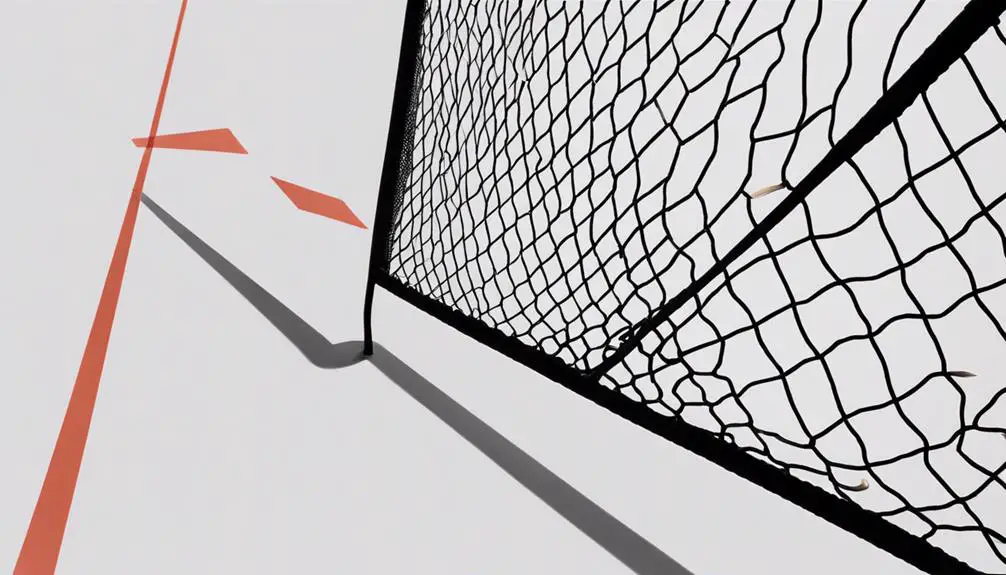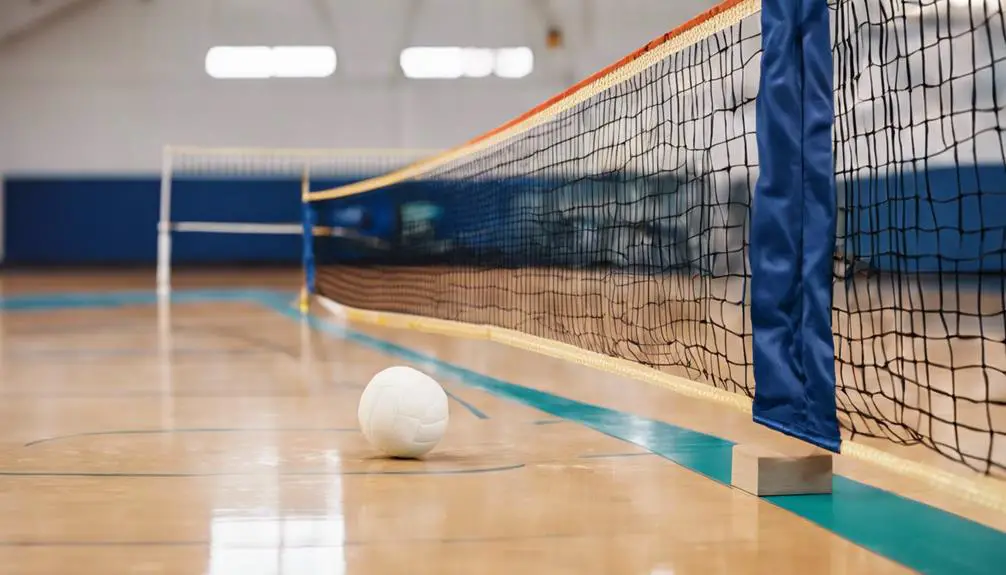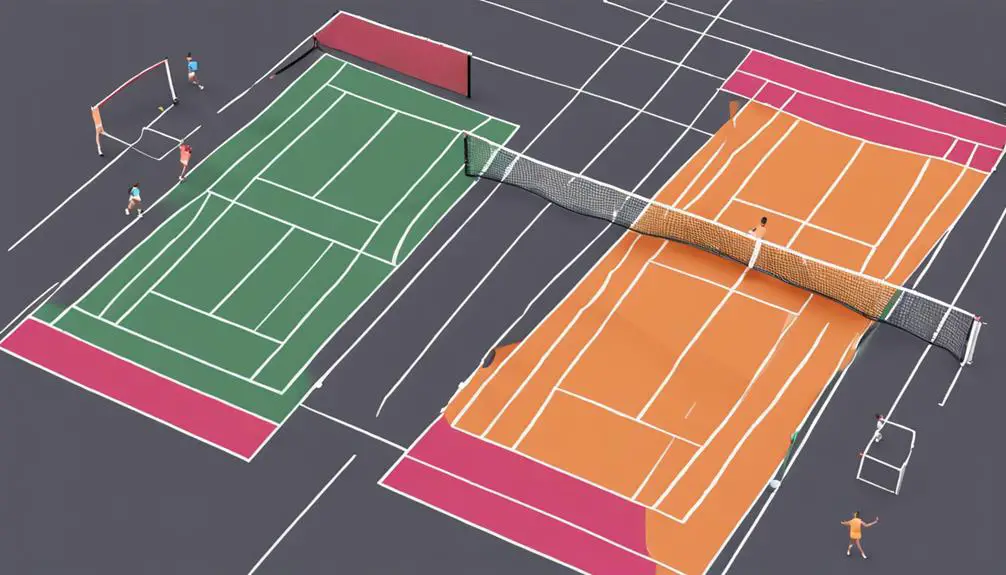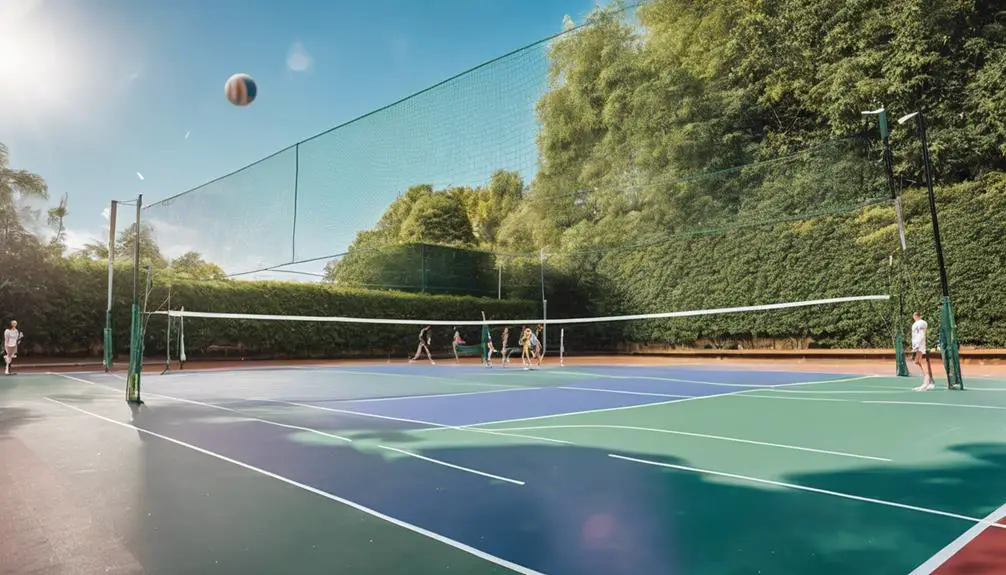When comparing badminton nets to volleyball nets, you'll notice significant differences in size, material composition, and design. Badminton nets are 20 feet wide and 5 feet high, made from a polyester and nylon blend, while volleyball nets are 32 feet wide and 8 feet high, constructed from heavier-duty materials. These differences impact gameplay dynamics and strategies, reflecting the unique demands and requirements of each sport. You'll also find variations in hole sizes, tension requirements, and court dimensions, all of which are essential for regulation compliance and ideal play. Further exploration will reveal even more distinct features and considerations.
Key Differences Between Nets

A badminton net and a volleyball net may look similar at first glance, but they have distinct differences regarding size, material, and construction. You'll notice the most obvious difference is in the size of the nets. Badminton nets measure 20 feet wide and 5 feet high at the center, whereas men's volleyball nets are considerably larger, measuring 32 feet wide and 8 feet high. This size difference is vital, as it affects the gameplay and strategy of each sport.
The material used in the construction of the nets also differs. Badminton nets are typically made from a polyester and nylon blend, which provides a suitable balance of durability and flexibility. Volleyball nets, on the other hand, are made from heavier-duty materials reinforced with wire for added strength and durability. You'll also notice that volleyball nets have a thick cord for tension adjustment, while badminton nets only require top tension to maintain their height.
Furthermore, the hole size in the nets is another key difference. Volleyball nets have larger holes to accommodate the size of a volleyball, while badminton nets have smaller holes to prevent shuttlecocks from passing through. These differences highlight the unique requirements of each sport and the importance of using the correct equipment to guarantee fair play. By understanding these differences, you can appreciate the distinct characteristics of each net and the sports they serve. The size, material, and construction of the nets are fundamental to the gameplay and strategy of badminton and volleyball.
Net Design and Materials
You'll notice significant differences in the net structure and materials used for badminton and volleyball nets. Badminton nets have smaller holes and are typically made from a nylon blend, which provides flexibility and resilience against shuttlecock impacts, whereas volleyball nets have larger holes and often use heavier-duty materials reinforced with wire for greater durability. These distinct design choices are largely driven by the unique demands of each sport, with badminton prioritizing speed and agility, and volleyball requiring strength and power.
Net Structure Comparison
Net structure is a critical component in both badminton and volleyball, with each sport's unique demands influencing the design and materials used in their respective nets. When you compare badminton and volleyball nets, you'll notice significant differences in their dimensions. Badminton nets stand at a fixed height of 1.55 meters (5 feet) at the center, while volleyball nets vary in height, set at 2.43 meters (8 feet) for men's play and 2.24 meters (7.4 feet) for women's play. The width of badminton nets is approximately 20 feet (6.1 meters), providing a narrower space for fast exchanges, whereas volleyball nets are typically 32 feet (9.75 meters) wide to accommodate the larger court size.
You'll also notice that volleyball nets include a thick cord along the top and bottom for tension adjustment, necessary for maintaining the structure during play. In contrast, badminton nets only require tension at the top to avoid sagging. These design differences reflect the unique demands of each sport, with badminton nets prioritizing lightweight durability and quick gameplay, while volleyball nets focus on strength and the ability to withstand powerful impacts.
Net Material Differences
While the structural differences between badminton and volleyball nets are notable, the materials used in their construction also play an essential role in meeting the unique demands of each sport. You'll find that badminton nets are typically made from a blend of polyester and nylon, providing resilience against the impacts of shuttlecocks during fast-paced play. In contrast, volleyball nets are constructed using heavier-duty materials, often reinforced with wire, to withstand the powerful volleys that occur in the sport.
The design of the net system also differs markedly between the two sports. Badminton nets feature smaller holes to prevent the shuttle from passing through, while volleyball nets have larger holes to accommodate the size of a volleyball. Additionally, badminton nets require only top tension to remain taut, whereas volleyball nets include a thick cord along the top and bottom for adjustable tension to maintain proper height during play. The durability and material choices in volleyball nets reflect the sport's needs for handling intense physical play, while badminton nets are designed for speed and quick exchanges. These differences in material and design guarantee that each net system meets the specific requirements of its respective sport.
Dimensions and Height Requirements

The dimensions and height requirements of badminton and volleyball nets are vital elements that greatly impact gameplay and strategy. You'll notice that badminton nets stand at a fixed height of 1.55 meters (5 feet) at the center, while men's volleyball nets tower above at 2.43 meters (8 feet) high for competitive play. Women's volleyball nets, on the other hand, require a height adjustment to 2.24 meters (7.4 feet).
The width of the nets also differs considerably. Badminton nets span approximately 6.1 meters (20 feet), whereas volleyball nets stretch 9.75 meters (32 feet) across. These dimensions cater to the distinct gameplay styles and requirements of each sport. Badminton nets are designed to be tensioned to avoid sagging, whereas volleyball nets feature a thicker cord for both top and bottom tension adjustments.
These differences in dimensions and height requirements influence strategies and player dynamics. In badminton, the lower net height allows for faster-paced gameplay and more agile movements. In volleyball, the higher net height demands more powerful spikes and precise blocks. Understanding these nuances is vital for players to excel in their respective sports. By recognizing the unique dimensions and height requirements of each net, you can adapt your gameplay and make the most of your time on the court. Whether you're a seasoned pro or a beginner, knowing the specifics of each net can elevate your performance and enhance your overall experience.
Interchangeability of Nets
You'll notice that the structural integrity of badminton and volleyball nets differs markedly, with distinct tension and material requirements that cater to each sport's unique dynamics. As you compare the two, it becomes clear that using a volleyball net for badminton or vice versa would compromise the gameplay experience, due to the mismatch in net specifications. This disparity highlights the importance of sport-specific net requirements, underscoring the need for distinct net designs that meet the regulations and demands of each sport.
Structural Integrity Differences
Numerous differences in design and construction render badminton and volleyball nets structurally incompatible for interchangeable use. You'll notice distinct variations in height, tension, and width that make each net suited for its respective sport.
When comparing Volleyball and Badminton Nets, consider the following key differences:
- Height: Badminton nets stand at 1.55 meters, while men's volleyball nets tower at 2.43 meters.
- Tension and Construction: Badminton nets require only top tension, whereas volleyball nets have a thick cord for tension adjustment at both the top and bottom.
- Width: Volleyball nets span approximately 32 feet, while badminton nets stretch about 20 feet.
These differences reflect the unique demands of each sport. Volleyball nets are built with heavier-duty materials to withstand powerful volleys, while badminton nets use lighter polyester and nylon blends for shuttlecock impacts. Using the incorrect net can disrupt gameplay and violate sport regulations, emphasizing the importance of each sport having specific net requirements. By understanding these structural integrity differences, you can appreciate the distinct needs of Badminton and Volleyball.
Sport-Specific Net Requirements
Every sport has its unique requirements, and badminton and volleyball are no exception when it comes to net specifications. You can't simply swap out one net for the other, as each sport's net is designed to meet specific demands. Badminton nets, for instance, are fixed at 1.55 meters high and 20 feet wide, while volleyball nets stand at 2.43 meters high and 32 feet wide. This significant difference in height – volleyball nets are roughly 1.5 times taller – makes them unsuitable for interchangeability.
The sport-specific net requirements also extend to tension and material. Badminton nets require only top tension to prevent sagging, whereas volleyball nets need adjustments along both the top and bottom. The materials used for each net also differ, with badminton nets made of lightweight polyester or nylon blends and volleyball nets constructed with more robust materials to withstand heavier volleyballs. Using the wrong net would disrupt gameplay and fairness, as each sport's regulations specify unique net specifications to cater to their distinct playing styles and dynamics. Understanding these differences is vital for players, officials, and equipment manufacturers alike.
Importance of Correct Nets

Employing the correct net is vital in both badminton and volleyball, as it directly affects gameplay dynamics and compliance with official regulations. Using the wrong net can compromise gameplay quality and fairness. When you use a badminton net for a volleyball game, the notably shorter height can lead to an uneven playing field, disrupting the sport's integrity.
Here are three important implications of using incorrect nets:
- Regulation non-compliance: If you use a net with the wrong height or width, you're not following the official rules of the game, which can lead to disqualification or disputes.
- Gameplay disparity: Different net heights and widths can greatly affect gameplay. For example, the lighter and shorter badminton net can't withstand powerful volleys, while a volleyball net's durable materials are designed to handle intense action.
- Competitive disadvantage: When players are accustomed to the specific conditions of their sport's net, using a different net can hinder their performance and create an unfair competitive environment.
Utilizing the correct net is essential for maintaining the overall sporting experience. It directly affects gameplay dynamics and fair play. Incorrect nets can lead to player dissatisfaction and hinder enjoyment of the game. Understanding the importance of correct nets highlights the need for strict compliance with official regulations. Make certain you're using the right net for the sport to guarantee a safe and enjoyable experience for all participants.
Net Specifications and Regulations
Net specifications and regulations are a vital component of both badminton and volleyball, with each sport having its own unique requirements. You'll notice the height of the net is a key difference. Badminton nets stand at 1.55 meters (5 feet) high at the center, whereas men's volleyball nets are 2.43 meters (8 feet) high and women's volleyball nets are 2.24 meters (7.4 feet) high. The width of the net also varies, with badminton nets spanning 20 feet (6.1 meters) and volleyball nets stretching 32 feet (9.75 meters) wide.
The construction of the net itself is also distinct. Badminton nets require tension to prevent sagging, while volleyball nets feature a thick cord along the top and bottom for tension adjustment. The hole size in the net is another key difference. Badminton nets have smaller holes to prevent the shuttlecock from passing through, while volleyball nets have larger holes to accommodate the size of a volleyball.
Volleyball nets also have specific height adjustments based on gender and level of play, while badminton nets have a fixed height regulated by sport governing bodies. Understanding these net specifications is essential for ensuring a fair and safe game. You'll want to familiarize yourself with the specific regulations for your sport to guarantee compliance. By recognizing the unique requirements of each sport, you'll be able to set up a net that meets the necessary standards, providing a high-quality playing experience for all participants.
Court Dimensions and Design

Examining the court dimensions and design of badminton and volleyball reveals distinct differences that cater to the unique demands of each sport. When you play badminton, you'll notice the court is smaller, measuring 20 feet wide by 44 feet long for doubles play. In contrast, volleyball courts are larger, spanning 30 feet wide by 60 feet long. This size difference affects the gameplay and strategies employed in each sport.
Here are three key differences in court design:
- Net height and width: Badminton nets stand at 1.55 meters (5 feet) high, while men's volleyball nets are set at 2.43 meters (8 feet) high for competitive play. Additionally, volleyball nets are approximately 32 feet in length, compared to the 20-foot width of badminton nets.
- Court markings: Badminton courts feature specific markings for singles and doubles games, whereas volleyball courts have a centerline and attack line to guide player positioning.
- Indoor and outdoor play: Badminton courts can accommodate both indoor and outdoor play, while volleyball courts are typically designed for outdoor use in recreational settings.
These design differences reflect the unique requirements of each sport. As you pack your carrying bag with your badminton or volleyball gear, consider how the court dimensions and design will impact your gameplay. By understanding these differences, you'll be better equipped to adapt your strategy and enjoy a more satisfying playing experience. Whether you prefer the fast-paced action of badminton or the teamwork-oriented nature of volleyball, the court design plays a significant role in shaping your experience.
Historical Context and Popularity
Over two centuries, the racquet sport of badminton and the team-oriented game of volleyball have evolved considerably, shaped by their unique histories and rising popularity. You'll find that badminton has its roots in the mid-19th century, emerging from the game of battledore and shuttlecock, while volleyball was created in 1895 by William G. Morgan, who drew inspiration from basketball and tennis.
You'll notice that badminton's growth has been particularly significant in Asia, with countries like China and Indonesia leading the charge, making it one of the most popular racquet sports worldwide. Volleyball, on the other hand, enjoys widespread participation, particularly in schools and recreational leagues, contributing to its status as a globally recognized sport. The evolution of badminton nets has been influenced by competitive play standards, while volleyball nets have been designed to enhance durability and gameplay, reflecting their respective sport's development.
As you spend your summer days playing either sport, you'll appreciate the distinct histories that have shaped them. Badminton's popularity in Asia has led to the creation of specialized equipment and training methods, while volleyball's global reach has driven innovation in net design and gameplay strategies. Despite their differences, both sports have seen a rise in casual play and community engagement, with multi-sport nets promoting friendly interactions among families and recreational players. By understanding the historical context and popularity of badminton and volleyball, you'll gain a deeper appreciation for the unique characteristics of each sport.
Casual Multi-Sport Equipment Options

Several manufacturers now offer casual multi-sport equipment options, catering to families and recreational players who want to enjoy various sports, including badminton and volleyball, without investing in separate gear. These portable systems prioritize versatility and convenience, allowing you to play multiple sports with minimal setup and equipment changes.
When shopping for a casual multi-sport equipment option, you'll typically find the following features:
- Adjustable net height: Many systems allow you to adjust the net height to accommodate different sports, such as badminton (1.55 meters or 5.1 feet) and volleyball (2.21 meters or 7.3 feet).
- Portable and lightweight design: Weights ranging from 2.9 kg to 4.5 kg (6.4 lbs to 9.9 lbs) make it easy to transport and set up the equipment in various locations.
- Complete recreational net system: A 24-foot long and 3-foot high net provides ample space for both badminton and volleyball play styles.
Easy setup is a key benefit of these casual multi-sport equipment options. With a lightweight design and simple assembly process, you can quickly get started with your favorite sport. Additionally, many systems come with essential accessories like badminton rackets and volleyballs, allowing you to engage in multiple sports with a single purchase. By investing in a casual multi-sport equipment option, you'll enjoy the freedom to play various sports without the hassle of separate gear and complicated setup procedures. This flexibility makes it an ideal choice for families, recreational players, and those seeking a convenient way to stay active.
Frequently Asked Questions
Can You Use the Same Net for Volleyball and Badminton?
You'd have to be crazy to think you can use the same net for volleyball and badminton – it's like trying to fit a square peg into a round hole a million times! The net specifications are worlds apart. Volleyball nets are a whopping 2.43 meters tall, while badminton nets are a mere 1.55 meters. The width, material, and tension requirements are also vastly different. Sorry, but you'll need separate nets to guarantee fair play.
What Is the Difference Between Badminton and Volleyball Sports?
You're comparing two distinct sports – badminton and volleyball. The primary difference lies in their gameplay mechanics. Badminton emphasizes swift, agile movements and rapid-fire shots, while volleyball focuses on strategic teamplay, powerful spikes, and blocks. You'll notice badminton's faster-paced gameplay, whereas volleyball's more about coordination and tactical positioning. These differences shape the skills you'll need to master and the strategies you'll employ in each sport.
Can We Play Volleyball in a Badminton Court?
You can't play volleyball in a badminton court due to significant differences in court dimensions. A badminton court is 20×44 feet, while a volleyball court is 30×60 feet. The smaller badminton court wouldn't accommodate volleyball's gameplay, and the lower net height would alter the game's dynamics. You'd face difficulties with serves, spikes, and blocks. The court's constraints would limit your freedom to play volleyball effectively.
What Is Badminton Net Height?
Hold the racquet, let's plunge into the nitty-gritty! When it comes to badminton, you'll want to know the net height is 1.55 meters (5 feet) at the center. According to Net Specifications, this height remains constant for both singles and doubles play. A slight variation of 1.524 meters is allowed for official tournaments. Make sure the net is properly tensioned and secured to the posts without gaps for a fair game – your freedom to play depends on it!




